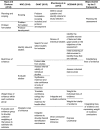Weight of Evidence for Hazard Identification: A Critical Review of the Literature
- PMID: 30024384
- PMCID: PMC6108859
- DOI: 10.1289/EHP3067
Weight of Evidence for Hazard Identification: A Critical Review of the Literature
Abstract
Background: Transparency when documenting and assessing weight of evidence (WOE) has been an area of increasing focus for national and international health agencies.
Objective: The objective of this work was to conduct a critical review of WOE analysis methods as a basis for developing a practical framework for considering and assessing WOE in hazard identification in areas of application at the French Agency for Food, Environmental and Occupational Health and Safety (ANSES).
Methods: Based on a review of the literature and directed requests to 63 international and national agencies, 116 relevant articles and guidance documents were selected. The WOE approaches were assessed based on three aspects: the extent of their prescriptive nature, their purpose-specific relevance, and their ease of implementation.
Results: Twenty-four approaches meeting the specified criteria were identified from selected reviewed documents. Most approaches satisfied one or two of the assessed considerations, but not all three. The approaches were grouped within a practical framework comprising the following four stages: (1) planning the assessment, including scoping, formulating the question, and developing the assessment method; (2) establishing lines of evidence (LOEs), including identifying and selecting studies, assessing their quality, and integrating with studies of similar type; (3) integrating the LOEs to evaluate WOE; and (4) presenting conclusions.
Discussion: Based on the review, considerations for selecting methods for a wide range of applications are proposed. Priority areas for further development are identified. https://doi.org/10.1289/EHP3067.
Figures




References
-
- Adami HO Sir Berry CL, Breckenridge CB, Smith LL, Swenberg JA, Trichopoulos D. 2011. Toxicology and epidemiology: improving the science with a framework for combining toxicological and epidemiological evidence to establish causal inference. Toxicol Sci 122(2):223–234, PMID: 21561883, 10.1093/toxsci/kfr113. - DOI - PMC - PubMed
-
- ANSES (Agence nationale de sécurité sanitaire de l’alimentation, de l’environnement et du travail). 2012. IAvis et rapport de l'ANSES relatif à l'Étude des liens entre facteurs de croissance, consommation de lait et de produits laitiers et cancers [in French]. Maisons-Alfort, France: ANSES.
Publication types
MeSH terms
Substances
LinkOut - more resources
Full Text Sources
Other Literature Sources
Medical
Molecular Biology Databases

